Intern Weekly Response: Podcast Nation
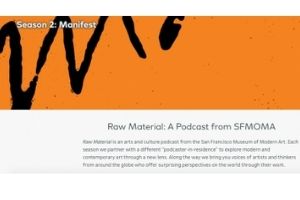
Every week we’re asking our summer interns to share some thoughts and responses to various experiences and readings. This week we asked them to explore the world of museum-related podcasts and share their reviews and recommendations with you! To read more posts from JMM interns, past and present, click here.
Stuff You Missed In History Class: A Review
By Collections Intern Amy Swartz
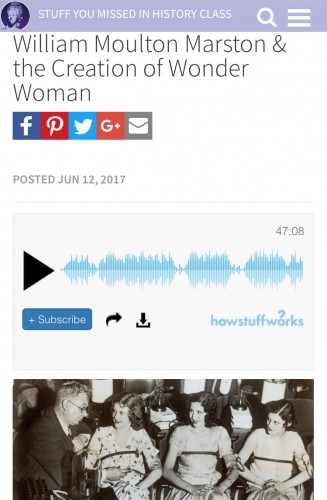
This week I learned more about podcasts and the ways they can be utilized to teach history and accompany a museum’s collections. The podcast that intrigued me the most was the series Stuff You Missed In History Class by the website How Stuff Works, and hosted by Tracy V. Wilson and Holly Frey. I listened to three of their podcasts: William Moulton Marston & the Creation of Wonder Woman, The Ladies of Llangollen, and Elisabeth Louise Vigée Le Brun. The podcast series bring up interesting topics that one would have never learned in a history class – often because the topics are personal stories, niche subjects, or detailed biographies. However, the series brings to light many histories that are often left to the shadows; like lgbtqa or women’s history.
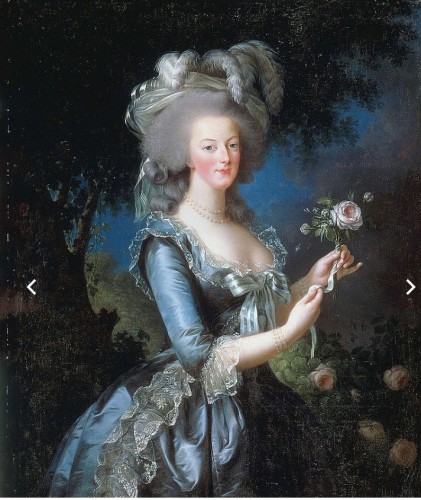
The podcasts start out by introducing the topic and then tells the story of whichever history they are talking about – often with little comedic quips. Each podcast ends with answering listener’s questions that were sent in after previous episodes, encouraging viewers to subscribe to the series. The podcasts do a really good job of making the historical story relatable to modern audiences. However one of the hang-ups is simply that podcasts are auditory and not visual. I found myself having to stop and google pictures of the subjects of the podcasts or works related to them. I am a visual learner so being able to see paintings or portraits is important to me for understanding a story. That being said, the two women do a really great job of being descriptive and weaving the story so that no outside resources are needed. Ultimately, I would recommend Stuff You Missed In History Class as it is a fun informative series that covers such a large group of topics that anyone listening to it could find a topic that they think is interesting.
Museum Podcasts Bring the Museum to Life
By Education Intern Erin Penn
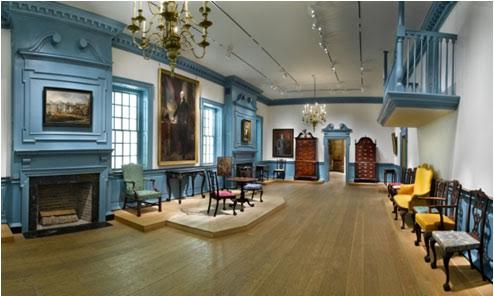
At Museums: Invasion of the Podcasts tells of the new and exciting trend of supplementary podcasts throughout museum exhibits. The audio is used to create a different culture at Museums, engaging the visitors in a more immersive fashion through simultaneously hearing while they see what the museum has to offer. Nate DiMeo’s museum related podcast; “The Memory Palace” discusses several art pieces and galleries at the Metropolitan Museum of Art in New York City. I specifically listened to episode three and six.
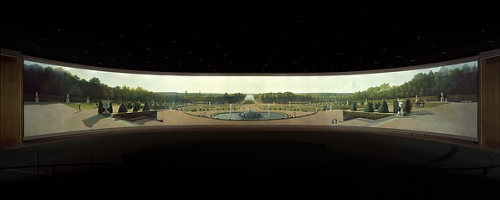
DiMeo’s podcast tells stories about specific rooms or paintings at the Met. Episode Three: Full Circle discuses John Vanderyln’s Panoramic View of the Gardens of Versailles. Episode Six: If You Have to be a Floor focuses on Gallery 719 the Alexandria Ballroom. A key feature and strength of these podcasts is the incorporation of background music. These orchestrations match with the time period and the setting. For instance, when discussing Vanderyln’s time in Paris the music has a quicker flashier tempo to encapsulate the vitality of France he experienced. In episode six, music plays an even more prominent role. DiMeo pushes the viewer to experience an eighteenth century ballroom, even asking the listener to dance along. The artwork and rooms come alive as the music transports the viewer to the past, exemplifying the influence of museum podcasts.
Contemporary Art Podcast Pushing the Boundaries of Museum Podcasts
By Collections Intern Joelle Paull
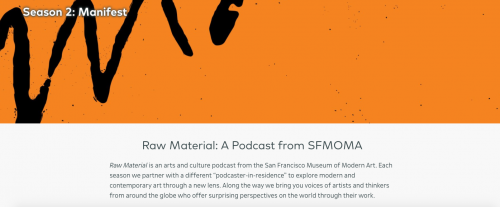
Raw Material, the San Francisco Museum of Modern Art’s arts and culture podcast, is currently in its second season. It is not the museum’s first venture into podcasting, but it is certainly SFMOMA’s most highly produced. Where as many museum podcasts focus on collections or current exhibits, Raw Material looks outside of the museum and weaves together interviews with and experts from contemporary artists into larger narratives. Season two, entitled “Manifest,” explores how artists occupy and navigate the space around them, featuring artists like James Luna, Mildred Howard, and Xandra Ibarra. Each episode is surprisingly succinct, given the depth at which topics are explored, and thoughtfully crafted.
Recommended Episode: Manifest (season two) Episode 3: Home
I usually opt out of audio tours at museums, wanting to focus on the works and experience (with the exception of archeological sites.) So, as a museum lover and avid podcast listener, I was excited to explore an art podcast that was independent of the museum’s collection, yet explored art in a meaningful way. The biggest challenge in an art podcast is translating something primarily visual into an audio format, perhaps even more so with ephemeral contemporary works. I fully expected to feel as if something was missing, but I did not. Manifest’s host, Geraldine Ah-Sue, and the many artists’ interviewed describe the work in great details, incorporating sound from performances when applicable. The museum provides additional material on the podcast’s webpage, including longer interviews with artists, images, and videos. Although each episode could stand alone, the additional material is a nice addition for the listener. The podcast’s greatest strength greatest strength is the way in which it uses narratives in individual works to discuss broader issues of social justice and identity.
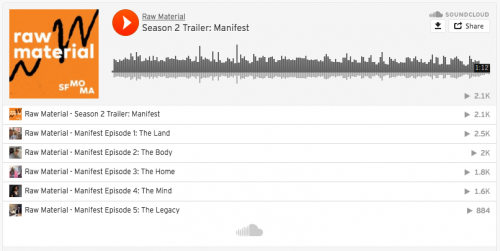
Encryption is Fun!: A Review of the International Spy Museum’s Spycast
By Exhibitions Intern Tirza Ochrach-Konradi

I’m a little bit obsessed with encryption and codebreaking so when I realized the International Spy Museum publishes the podcast Spycast, which delves into various intelligence gathering topics, I was hooked! The series is hosted by Vince Houghton and in each of the three episodes I listened to Houghton was joined by another participant who had particular knowledge to share about a specific part of intelligence gathering. The podcast takes an interview format. Houghton asks his guests a series of questions which delve into the week’s topic. The podcast has few frills. The content is presented in a straightforward conversation without inclusion of outside recorded material.
Suggested episode: David Kahn on Codebreaking from Ancient Times to the Internet Era
This is a very smart strategy for the Spy Museum. Much of intelligence gathering is not particularly well suited to being displayed in a museum exhibition. Spying is the process of gathering and filtering information. There are some gadgets for field work that are great to display, but a lot of intelligence work is sifting through previously gathered information to find and interpret important content. There is little in this process that can be displayed in a museum. I spent a large part of my spring break reading through books on encoding and decoding tactics. I read chapter books on decoding tactics and I can’t imagine understanding any of the methods through a traditional exhibit. The podcast format allows the museum to delve deeper into the less glamorous parts of intelligence work. While an exhibit should be accessible to anyone who walks into the museum it is okay if one of the museum’s weekly podcasts depends on the listener having existing understanding. For instance, if I had not read an entire chapter on enigma machines in The Code Book: The Science of Secrecy from Ancient Egypt to Quantum Crpytography, I wouldn’t have understood when David Kahn and Houghton were comparing enigma to the Japanese “purple” machines during their conversation about codebreaking. (A couple more reading suggestions: Secret Language: Codes, Tricks, Spies, Thieves, and Symbols, and The Friar and the Cipher: Roger Bacon and the Unsolved Mystery of the Most Unusual Manuscript in the World)

Suggested Episode: Author Debriefing: Queen of Spies Daphne Park, Britain’s Cold War Spy Master
The actual podcasts are great. Each episode is focused; there is no off topic rambling and the information shared is clear. I wish, however, that the organization of the episodes on the museum’s website was more effective. The collection is searchable by key word, available in one long list, or collected into lists of a couple reoccurring segments. It would be helpful if the museum would put together playlists of podcasts on a single topic or at least had a list of topics covered. Making the podcasts does the work of sharing information which cannot be exhibited in the museum, but if the podcast archives are not well organized the information again becomes inaccessible.
Suggested Episode: Author Debriefing: NSA Codebreakers and the Secret Intelligence War Against the Soviet Union
Historically Black: A New Must-Listen Museum Podcast
By Education Intern Sara Philippe
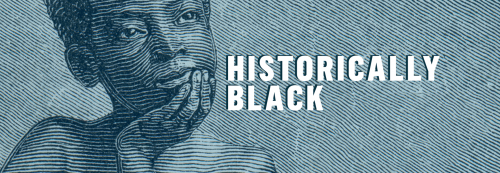
To begin my exploration of the world of museum podcasts, I listened to a couple episodes of Historically Black, a podcast sponsored by American Public Media and the Washington Post. The podcast, which consists of eight episodes, tells the stories of personal objects submitted to the museum by people across the United States. Each episode, the hosts focus on one topic or a specific object, including the voices of the people who submitted personal items, their family members, historians, experts, etc.
In the first episode, Black Love Stories, the hosts interview various people who sent in images of wedding rings, wedding photograph collections, love letters, etc. and engaged in a compelling conversation about the history of marriage for African Americans and current popular culture depictions of it. I enjoyed how the episode managed to pack so much variety of discussion into a short 22-minute episode.
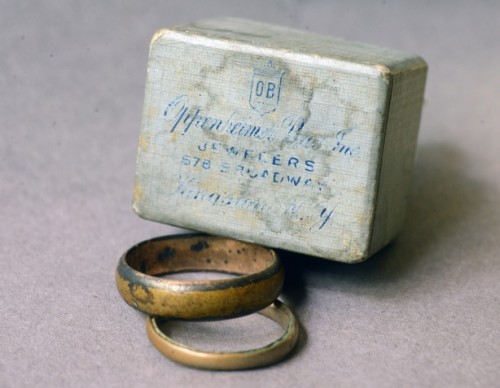
Interviewees who contributed their family’s stories of marriage talked about the lack of media depictions of loving, supportive black couples and the need for the more complicated kind of treatment of marriage and family that white Americans receive in television and film. A historian and professor offered a brief history of black marriage during slavery and its condition of illegality, while other interviewees emphasized the role of the illegality of black marriages in endowing it with more meaning today. The episode ended with a focus on a black lesbian pastor couple and the challenges they have faced as gay people who are also devoted Christians living in black communities. I loved that the episode centered on personal stories like these, and allowed several people to delve into their families’ particular stories of hardship and joy, while also constantly grounding these narratives in the necessary historical context.
Episode 6 of Historically Black, Tracking Down a Slave’s Bill of Sale differs from Episode 1 in that it is entirely about one family’s copy of a bill of sale of their great-great-grandfather, an enslaved man born in 1815 to an enslaved woman and her white owner. The episode features interviews with several members of the family and follows them as they go to the courthouse where the original version of the bill of sale is located and the farm and graveyard where their ancestor lived following emancipation. We hear them describe the mixed emotions that surround the possession of this document, as well as the actual sounds of the environment as they observed the headstones on the farm, a nice touch that made the episode feel very intimate.
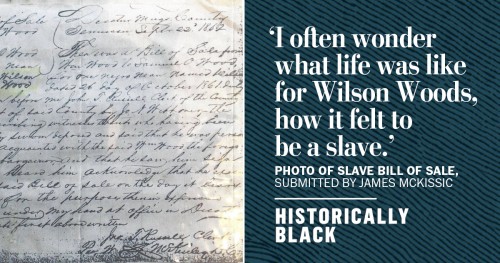
I appreciated how the hosts put this one family’s history, and the emotions attached to it in context, explaining the difficulty of tracking history and genealogy for so many African American families, and the lack of documents and items that provide personal glimpses at the past, rather than slavery-related documents that reinforce its devastating impact on black life. I love how both of these episodes enlighten listeners in terms of American history and today’s culture, while also giving voice to everyday people.
Hawaii in WWII, traveling back in time to paradise through Podcasts
By Exhibitions Intern Ryan Mercado.
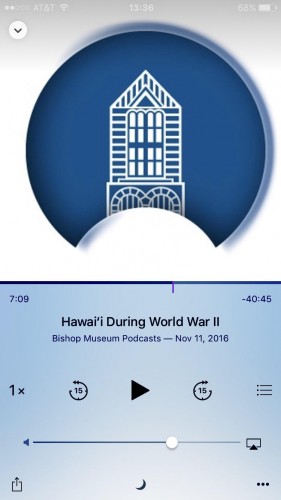
I don’t normally listen to Podcasts much, but I have done one audio tour of a historic canal which I thought was very good. That’s why the assignment to look into Museum-based podcasts this week for the blog particularly interested me. I decided I wanted to listen to a podcast about a topic I had no knowledge about whatsoever, so I went through iTunes and eventually stumbled upon the Bernice Pauahi Bishop Museum. I had no idea where this Museum was until a quick google search put the Museum in Honolulu, Hawaii. What could be more interesting than Hawaiian history? I skimmed through the episodes and decided to listen to two episodes about Hawaiian society and day-to-day living during WWII, and also one about Japanese internment camps in Hawaii.
The formats of the podcasts were as I expected an interviewer with a Museum historian or curator who discussed the subject matter. For me personally, I can sit through a college lecture, but podcast lecture is a new feeing for me. I listened attentively and I actually really enjoyed the content I was hearing. The speaker wasn’t just listing off mundane facts but given anecdotal stories and knowledge about how Hawaiians experienced the war. I learned that during the war, Hawaii did not use US currency, but “War Money” issued by the military. The reason for this is because the US Government did not want US dollars to fall into Japanese hands if the Islands were ever invaded. I also learned that the school that President Obama attended was forcibly seized during the war and used for military operations. As a historian, that’s really cool information to learn!
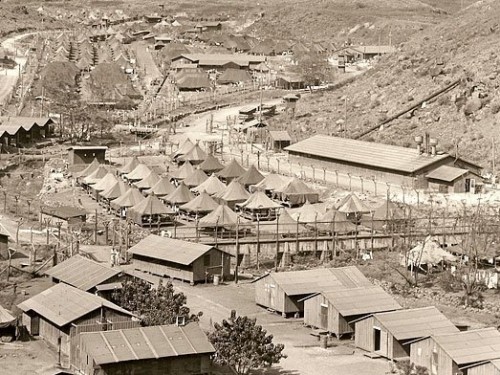
The second episode dealt with internment camps in Hawaii, which there were few. In fact, most people don’t even know that there were camps in Hawaii. The state had a 40% Japanese population at the time of the war and the US Government obviously could not round up 40% of the population, which would be crazy! So, in the state that was in the epicenter of the Pacific Theatre, the US Government had to be strategic about which Americans of Japanese descent would be rounded up and put in the camps. Obviously this history is hard to listen to, but I find it refreshing. The speakers were clear and crisp and I was interested all the way through the 45 minute lectures. Perhaps I should listen to more podcasts; after all, I need something to listen to on my 2 hour commute home every day!
